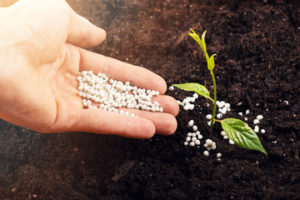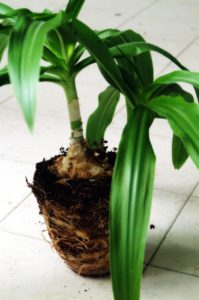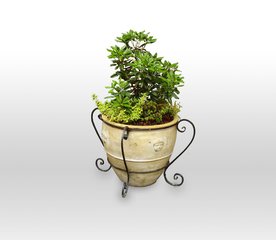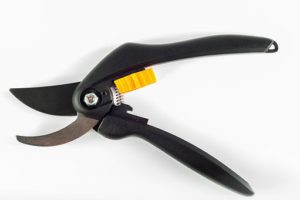MAINTAINING PERMANENT PLANTS IN CONTAINERS
If you have plants that have been many years in pots and planters, they need various general maintenance procedures to be carried out. This is done in order for the plant to not only survive but flourish from one year to another. It is beneficial if these routine checks are carried out throughout the year, and especially spring which is an important time for which plants get the nutrients they require for the forthcoming growing season.
TOPDRESSING AND GENERAL FEEDING
As the compost ages, it starts to lose its vitality, in that the nutrients available to the plants are slowly being reduced over time. To counteract this new feed has to be introduced in the container every year.

This is accomplished by taking away the first few centimetres of compost and then replacing it with new compost mixed with the required dosage of slow release fertilizer. In effect, you would use a rose fertilizer for roses and shrubs, a general fertilizer for non-ericaceous plants, and an ericaceous fertilizer for acid-loving plants such as pieris and camellias.
RE-POTTING TO A LARGER POT
As the plants start to grow, it will eventually look unruly, untidy and unbalanced. It can also become root bound where the roots start sticking out at the bottom of the container through the drainage holes or that large amounts of water are required to keep the plant happy (it will wilt in dry weather, and increasing amounts of water are required to stop the plant from wilting).

If you notice that the plant requires more water or it is constantly wilting then it is time to be re-housed into the next available pot size up. This usually takes place every couple of years, but this is so dependent on the plants in the container. Some plants grow quickly, whilst others grow at a more sedate pace.

PRUNING
Plants in containers such as some shrubs require just as much pruning as those who are planted directly into the ground. Pruning is required to remove dead, crossing branches, as well as those who are starting to grow inwards (as they will get less light). Evergreen shrubs have a more formal method of pruning called topiary (see later on) in which errant branches are cut to bring the plant to a better, formal shape.

SURVIVAL
Tender plants may need to be brought into a conservatory, garden room or greenhouse, or even the house if you do not have anything else available. This is very important if you live in an area where cold, hard frosts are very common throughout late autumn to early spring.
If the plant is in such a large container and cannot be moved easily, then thick horticultural fleece (which can raise the temperature by 5 degrees Celsius) or bubble wrap can be used as an alternative. These measures of covering the plants cannot be relied on to save them in a severe winter. It at all possible, it is recommended that you move the plant to be near a wall, especially a house wall, which can offer some heat and frost protection.
TOPIARY
Many evergreen garden shrubs such as box can be grown in containers, especially flanking either side of the entrance to a front door. The decorative effect of these plants can be enhanced by training these shrubs or by clipping them in a form known as topiary.

Many small leaved evergreen shrubs that are sufficiently fine textured and thick enough( that no visible gaps can be seen) can be shaped into many geometric shapes, such as spheres (balls), hemisphere (domes), pyramids, cones, or more complex designs such as spirals or animal shaped. All that is required to do the topiary task are a pair of secateurs, shears (commonly called lady shears) or scissors.
CREATING SHAPES INTRODUCE POINTS OF INTEREST
To create spheres and hemispheres, stand above the plant and turn the shears upside down so that the shape of the blade follows the curve. Keep walking around and keep standing back to view your progress. It is important that you keep the shear to the plant at all time, otherwise, it will not be a perfect sphere.

Secateurs can be used to shape large-leaved plants such as holly, bay or viburnums.
Flowering and berry producing shrubs can be shaped after they have flowered or produced their fruit.
No shrubs should be clipped between the end of summer to mid-autumn, as this encourages soft new growth of leaves and shoots. This new growth may not be fully hardy and could be damaged by severe frosts.
CONCLUSIONS
In this article, the importance of looking after well-established plants in containers needs to take place, as well as talking about topiary, the benefits of shaping your shrubs into.
If you have any questions or comments that you wish to raise, please do not hesitate to leave me a comment below and I will get back to you as soon as possible.
Thank you


You’ve hit the nail on the head with one of my favorite hobbies! Pot gardening is what I do, for it’s so much easier to take care of!
And I like your tips a lot! And that hanging basket with the lattice gate? I definitely want to check into that!
Thank you for the great ideas!
Hi Patty
It is always good to meet a fellow container gardener. There is such a large variety of plants that can be grown in them, which will be discussed in my future posts.
Thanks
Antonio
I do not have a green thumb at all so I found this article very informative and helpful. I will access your website in the next couple months as I plant flowers outside. I know you will most likely have great tips and advice for this beginner.
Thanks!
Sharon
Hi Sharon
Thank you for your kind words. Everybody starts without knowledge in gardening, and that is why I have developed this website for people like you, to become more confident in the skills required to be a gardener. Please come back as I have many ideas coming out in the future.
Thanks
Antonio
Hey man,
I know nothing about gardening but I suppose that’s because I live in a flat.
When you live in a house it’s like more or less you don’t have a choice but to start decorating your yard with some beautiful plants.
The advice you give is precious and I am going to refer to it anytime I decide to move to a house and start this green game!
Hi Asen
Thank you for your kind words. I know how hard it is to garden if you have no outdoor space or any room to plant, but don’t worry I will be launching a new category soon of houseplants, as all houseplants have to be grown in containers!
Thanks
Antonio
Hi Antonio
Thank you for this post, and for someone who is not the best gardener this will certainly help me look after my pot plants a little better.
Tim
Hi Tim
That is what my website is about, improving as a gardener every day. You never stop learner and I hope this will be of help in your future gardening endeavors.
Thanks
Antonio
Thanks for your very interesting article about PRUNING, TOPIARY AND GENERAL PLANT CARE. I love to plant flowers in containers. My love of container gardening started when we moved into a home that was surrounded by many large evergreen trees. The surrounding soil was too acidic to plant many things in ( at least with my limited knowledge). I resorted to having lots of containers, when I last counted my containers I had about 40.
I did notice after a few years that the soil in the containers was not providing all the nutrients a plant needs. Every few years I tend to dump out half the soil and top it up with fresh soil. The plants seemed to like that.
I mostly plant flowers that last for one season. I live in northern Canada and the winters are extremely cold. Our growing season is pretty short compared to other parts of the world. I have not had much experience with plants that grow back the next year.
I do enjoy my planting season and one year I planted all vegetables in my containers-that was fun! I had cucumbers growing on supports…looked pretty cool.
Thanks for your very informative article. You provided some great information.
Have an awesome day!
Angela
Thanks Angela
It is always of interest when you meet a fellow container gardener, and I can see you are one. Looking after long term container specimens are very important, as in the future they may not perform as expected.
I see that you grow veg in containers and this is a subject which I will discuss in a future article.
Thank You
Antonio
So a question, I have some succulents that are in a pot and I know they’re not supposed to be watered as often as a regular plant. How would I know when to change out the plant to a bigger pot? I have the blackest thumb and my mother got me a plant that she said I shouldn’t kill. Look forward to the tips.
Hi Jason
Succulents store moisture in their leaves and so do not require as much watering as regular plants, but they do need feeding once every two weeks or so. You can use a general liquid fertilizer (High Nitrogen for the leaves, and potassium for any Flowers) at the manufacturer’s recommended dosage, and no more.
To see if it need potting on, check to see if there are any root sticking out from the bottom and if the plant still looks sad (leaves wilting) after watering and feeding. Take the plant out of the pot and if it is root bound, it then needs to be moved on to the next pot size. Hope that helps.
Antonio
Okay yes this help, I did check if the roots are coming out as I was reading the article the first time I took a look no roots showing. I’ll get the fertilizer today, ha this is awesome! thank you, again you just may turn me into a green thumb type of guy!
Hi Jason
I am glad to be of service, I will make a hulk out of you yet
Thanks
Antonio
Hi, Antonio~!!! Your content is really helpful and informative~!! I’d like to keep some succulent plant inside my room since there is not that much outside space for me to do the gardening stuff. Can you share me some tips on how to keep the succulent plant?? Or, I can use the same tips that you mentioned?
Hi Zheng
Succulents store moisture in their leaves and so do not require as much watering as regular plants, but they do need feeding once every two weeks or so. You can use a general liquid fertilizer (High Nitrogen for the leaves, and potassium for any Flowers) at the manufacturer’s recommended dosage, and no more.
To see if it need potting on, check to see if there are any root sticking out from the bottom and if the plant still looks sad (leaves wilting) after watering and feeding. Take the plant out of the pot and if it is root bound, it then needs to be moved on to the next pot size. Hope that helps.
Antonio